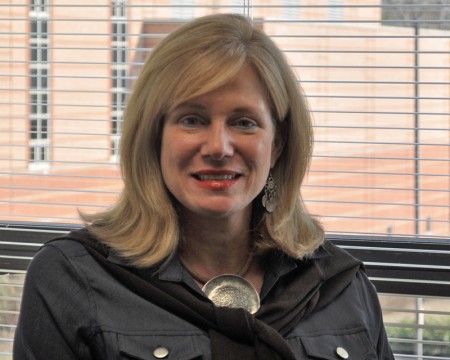
Christine LaPaille.
Christine LaPaille has served as George Mason University’s vice president for University Relations for over five years. A Chicago native, LaPaille has prior experience in public relations, politics and journalism. Despite the current budget cuts, LaPaille said she envisions Mason prospering, in both residential population and research over the next five years.
What is your educational background?
CL: I majored in journalism at Eastern Illinois University and I went to the University of Illinois, where I studied public policy and journalism for my master’s degree.
What jobs have you had before coming to Mason?
CL: I was the director of communications for the National Governors Association in Washington, D.C. for five years. I started my career as a Chicago Tribune reporter and a producer for ABC-TV in Chicago, where I covered politics and government. Then I became the communications director for the house minority leader in Illinois, and served as his chief of staff for about three years. After that, I opened my own public affairs firm in Chicago and operated it for ten years.
What attracted you to working here?
CL: I was initially recruited to apply for the job here by the former governor Mark Warner, who I had worked with in my previous job. I never heard of this university when I applied for the job. I just applied on a whim and realized that change-agent strategic communications is something Mason would really benefit from.
What are your responsibilities as vice president of University Relations?
CL: I manage multiple departments here: Media and Public Relations, Community Relations, Events Management, Creative Services and University Information.
How did you come up with Mason’s brand “Where Innovation is Tradition”?
CL: It was a two-year process and it became widely embraced by the university community.
Why do you feel that the brand represents Mason?
CL: Because according to market studies asking which of ten universities in the Washington [Metropolitan] region is most innovative, George Mason is always number one. So, whether that is true or not, and I believe it is true in many ways, it is part of our brand. Everyone thought that is us, because we do things differently here. People are told to just go for it. That is the kind of a place Mason is. The tradition piece is key, because as we approach our 40th anniversary, it is important to know you can’t change everything.
What has been your biggest challenge this year?
CL: Other than the budget, we must take the next media coverage steps for the university as a whole. But we are working on it.
What main issues are your office addressing?
CL: We are publicizing an interdisciplinary research portfolio and tackling the commuter- school reputation. We don’t think it’s all a bad thing, but we need to eradicate the notion that [commuters] are all we have here. I’m going to spend my advertising budget on this.
How has the economic downturn affected University Relations at Mason?
CL: My advertising budget has been cut by 90 percent. My ability to hire staff has been negatively impacted. We also have a huge problem with our website.
How do you envision Mason over the next five years?
CL: The research fund has increased by about $100 million since I started here. I think it will reach its goal of $150 million by next year. There will be close to 7,500 students on campus in a couple of years. Students are calling Mason home. I already see it happening.
Is there anything else you would like to add?
CL: Yes. My office is currently looking for a group of students that would film news stories for us. We want to build a corps of students with video-editing skills. The best way to contact my office is to call 703-993-8860 and ask for Kerri Cardoza.






Comments